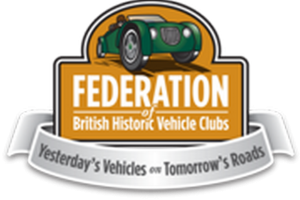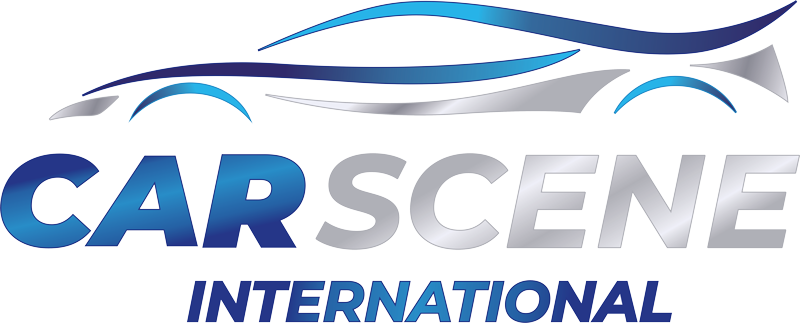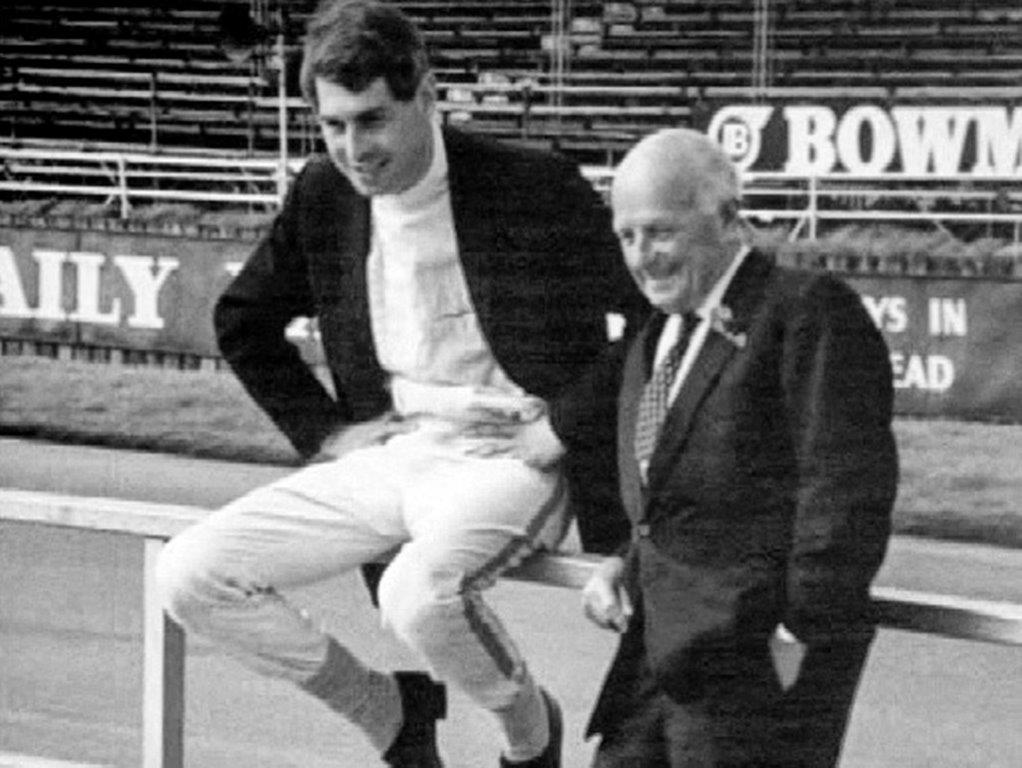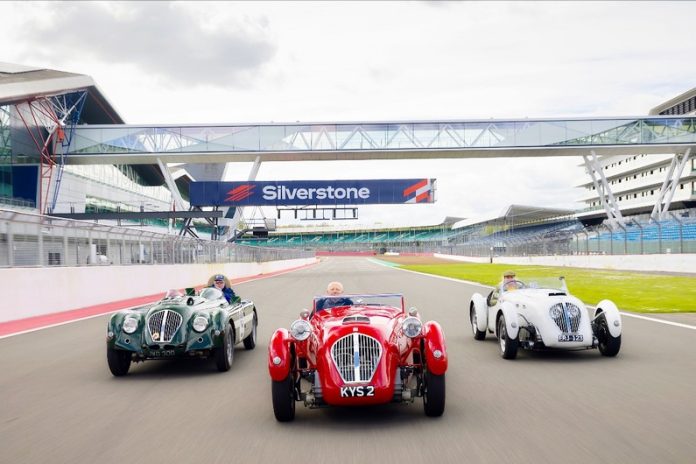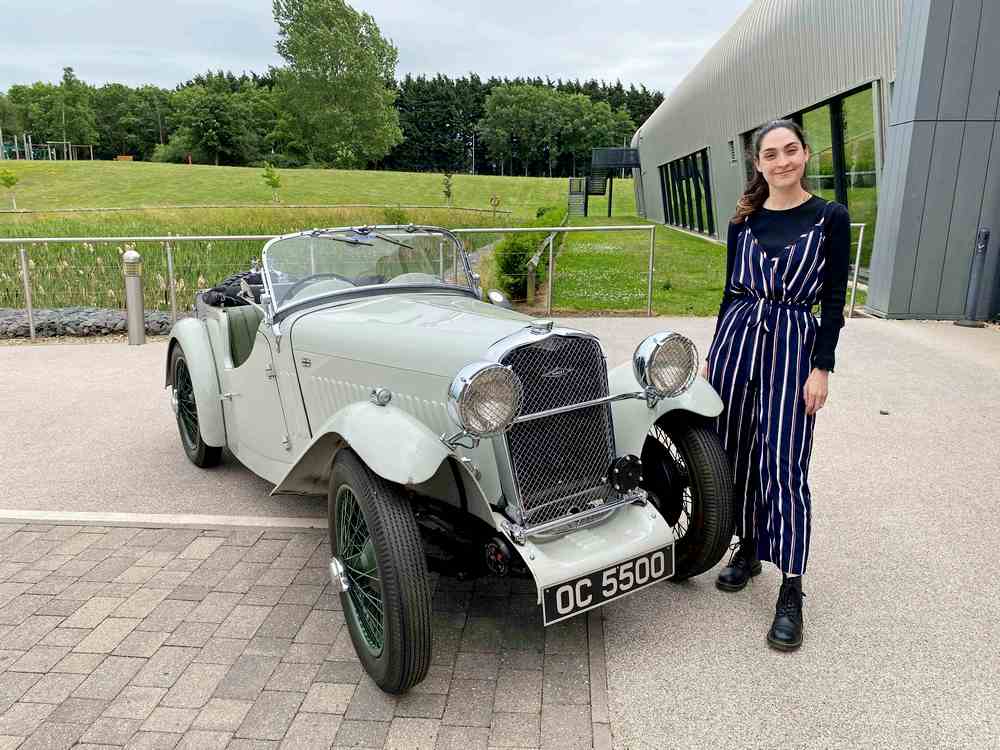On the morning of February 15, I received an email, from Malcolm Broughton, informing me of the sad news that John Harris, who drove for the Healey Works team in the 1960s, had passed away on Saturday 13th February, aged 82.
Many of you know that the Warwickshire County Record Office established an “oral history” project to compliment the Healey Motor Company archive which it had purchased in 2016. The idea was for volunteers to interview people who had some connection with Healey and its cars, particularly former employees. I was one of those volunteers and in May 2017 I conducted a recorded interview with John Harris. Transcripts were made of all the interviews and what follows is my interpretation of the John Harris interview transcript. The reason why it is my interpretation is because it eliminates obvious errors and improves the grammar of the original, thereby making it easier to read. I am publishing it now in memory of John, a brave human being and a true English gentleman.

Interviewer: It’s Wednesday the 17th of May 2017. My name is Nick Maltby. I’m a volunteer with the Warwickshire County Records Office, Healey Motor Company Archive project. I’m in the home of John Harris who was a Works driver for Healey. Good morning John. Thank you for agreeing to be interviewed. Let me begin by asking you about your childhood, schooling, and early employment experiences.
JH: Yes. Well, my father had a dental practice in Queen’s Road, Coventry and my mother was a member of the Davies family that owned the Parkside Motor dealership group. Its main showroom was in Warwick Road, Coventry, close to the junction with the ring road, although at the time, the ring road wasn’t even built. I was born in 1938, I was only two years old when Coventry was blitzed and all the windows were blown out of our house and we had to escape to Kenilworth to stay with some friends. Unfortunately, they (the Germans) came back a few weeks later and dropped a bomb by the Abbey Fields in Kenilworth. We then moved into the Queen and Castle pub (still there today, opposite Kenilworth Castle) for a while and then eventually out to a little village called Easenhall. I was at Coventry Prep school until I was thirteen and then I was sent off to Malvern College, Worcestershire, as a boarder. I certainly wasn’t very academically adept, I left without any significant qualifications, in the middle ‘50s. In the earlier part of the ‘50s, I noticed that an Austin Healey 100 started to appear in our road, opposite the house that I now live in. It (an AH 100) was owned by an eminent Coventry solicitor, John Venn, he used to race it. I was still at school and one day, in my last but one year at Malvern, I was taken down to Silverstone as a passenger in this Healey and I watched him race.

Interviewer: You were about fifteen were you then? Something like that?
JH: I left at seventeen, yes, fifteen or sixteen. I thought it was the most marvellous thing that had ever happened to me. And I was hooked on Healeys and on the idea of racing them. When I left school in ’56, like a lot of youngsters, I did not have much idea of what I wanted to do. I was somewhat limited because of the lack of academic qualifications, but, fortunately, my father, knew the Training Manager at Rootes. One of my uncles, on my mother’s side, had been trained at the Humber Motor Company, as it was then called. Eventually, I got a place there and did my three years pupillage with a day off to go to Coventry Technical College. The scheme itself was actually absolutely amazing because you had eighteen months where you were on the shop floor, all over the Stoke Plant, or, the Ryton Plant. Then for the next eighteen months you were in all the offices doing everything from filling wage packets…
Interviewer: Right. [Laughs] Including your own, I hope.
JH: Some of the work, in the Trainee School, I didn’t think so much of. One of the things that they would get you to do, when you first turned up, was filing exercises, cut up a piece of square metal, cut a square hole in the middle of it and make another piece of metal to fit it until you got it right.
Interviewer: You were learning precision.
JH: Precision, yes. That was all done by hand and it took forever. It could take three months to pass this test. I then went into the Service Department working in the Customer Care section, dealing with customer complaints and contacting the various dealers. I did about a year and a half of that and then I thought it was time to move. By that time I had already started to do a bit of motor racing. Fortunately, I then ended up in the Vehicle Test Department in the Engineering section in Humber Road. See ** below.
Interviewer: You mentioned that you started to do some car racing, what car did you race?
JH: In 1958 I had an Austin 7 Special which was open, it was like the Austin 7 from the ‘20s with the body cut off. I’d fallen off my motorbike and wrecked my only suit, a pair of suit trousers, so my mother said: “Here’s twenty-five quid go and buy a car”. So, that is what I bought. I started to do sprints and hill climbs with it. In ’59 I took out the Austin 7 engine and replaced it with a Ford 1172cc side-valve engine together with an MG J2 gearbox. I did one race but of course, you were in the middle of Lotus 6s and 7s in the same class.
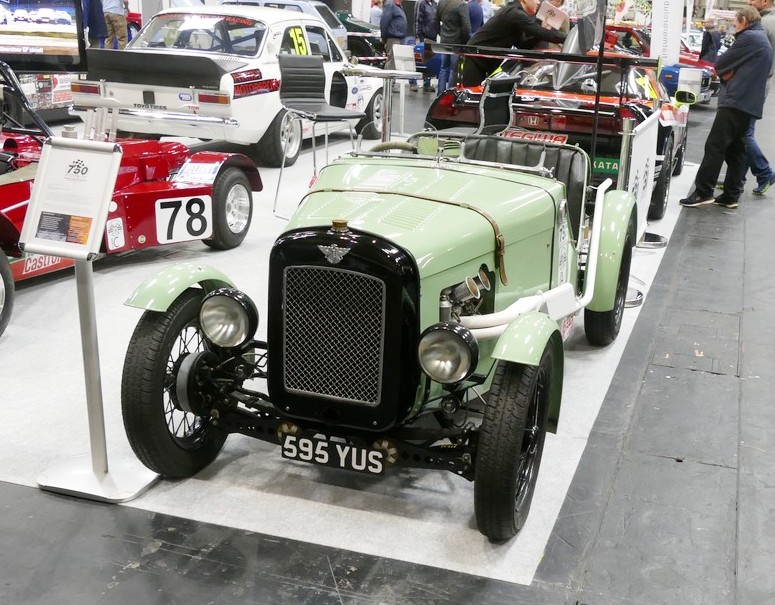
Interviewer: Was this to the 750 Motor Club Formula?
JH: Yes, that’s right. I only did one race, and then the family didn’t think it was safe, so, for 1960 I had a Mini, very kindly, they (his mother’s family, owners of the BMC Dealership, Parkside Garage) did a part exchange. My family said, “Well you must sell your 1172 Special, we’ll have that money to offset the cost of the Mini”. So, that’s what they did for my twenty-first birthday present, they couldn’t believe that I got a hundred and sixty quid for this 1172 cc Special. But, before I started racing the Mini, Eddie Maher who was Chief Engineer at Morris Engines, he lived about three hundred yards or so from a friend of my uncle’s, came to my aid. He gave me access to various bits and pieces of engine tuning equipment for my Mini. When I did my first race I was down at Goodwood, the opening meeting of 1960, March the 28th. There were a lot of other people one of them being Andrew Hedges (a well known U.K. racing driver at the time who also drove for Healey). He was in an Austin A40 in the same race as me. We were in a five lap Handicap race.

That was a fortuitous meeting and it went on from there. I’d always wanted to have a Healey but I couldn’t afford one. So, at the end of that year, I got rid of the Mini and bought a Sprite, a second-hand one, a Mk I, Frogeye. Through the Mini side of things, I got to know Daniel Richmond of Downton Engineering. He looked after me very well but I made a mistake. I put a Shorrock’s Supercharger kit on the Sprite and this caused you to be bumped up a Class. Even with a Shorrock’s blower and some special cogwheels that Chris Shorrock made for me, to increase the output, it wasn’t terribly successful.
There is an interesting story concerning Daniel Richmond – Bunty, his lovely wife, used to come and stay here because, at that time, Daniel didn’t have an engine testbed, so, Bunty would come up in the evening, drop an engine off at Morris Engines to have a power tech curve done on it through the night, then she’d go back the next morning and collect the engine before returning to Downton.
Interviewer: That really is a gem. Lots of people would be interested in that piece of information. So, you were in the Sprite, let’s move on, you are in the Sprite and what happened to that?
JH: What happened to that? I rolled it at Snetterton and because there was no roll-over cage I was carted off to Norwich Hospital. I’d flattened the windscreen and one of my friends, Jeremy Ainsley – Hackett, by name, towed the car back here to Coventry. I was whipped off to Norwich Hospital, they had a look at my hand and they said “Oh, the Plastic Surgeon needs to see this”. I was there for a while and then this guy turned up on a Sunday to have a look, he said “Well, you’ve got two choices. I’ll either operate tomorrow morning, you need some plastic surgery doing on your hand, or you can go back to Coventry”. I elected to return to Coventry where there was a wonderful Plastic Surgeon called Derrick Dencer. One of my mates brought me back here. My mother was on the phone to the GP, immediately, of course, he happened to be a life-long friend of my father’s, so he was round here in ten minutes. He had a look at my hand and he was soon on the phone to Derrick Dencer, he was round here half an hour later, unbelievable this is! Then he said to mum “Get him to George Eliot Hospital, Nuneaton, first thing in the morning, don’t give him anything to eat, I’ll do the job”.
It’s still there (the marks from the operation). He moved the whole of the back of my hand over and I had that on the top of the steering wheel and there you can see the scar left by the graft. It’s been there since 1960.
Interviewer: Unless you actually pointed that out and told me the story, you could hardly tell. There is a bit of a swelling on the knuckle, so he did a super job with that.
JH: That’s right. It was absolutely brilliant. He did some work on a friend of mine, rebuilt his face completely. Unbelievable.
Interviewer: So, the Sprite came back and it was a bit bashed up?
JH: Yes and I was back at Prescott about three weeks later.
Interviewer: Crikey. Amazing. How did you move on from the Sprite?
JH: Well I always wanted a Big Healey but I hadn’t got any money, so I bought this clapped out old 100-6 and set about it in the winter of 1961/2, to tune it up a bit.
Interviewer: Were your parents happy about this?
JH: Oh no, my father had died when I was eighteen. My mother put up with it. She had one requirement, that the minute I finished a race, I was to get to the phone box and phone her.
So, anyway, I got this Austin Healey 100-6, and I did all the bits and pieces but it was still not the 3 litre engine, it was a 2.6 engine and so, I had a pretty dodgy year in ’62. I only got the odd place. But for ’63, I thought, “I’ve got to do this properly”. I obtained a short 3 litre engine from the local Austin dealer, which I think cost a hundred quid and then all the bits came from all over the place. Derek Frost was a cam-shaft designer for Eddie Maher and he was the guy that was responsible for putting the Mini Cooper S cam profile on the Big 6 cylinder Austin engine, this was the beginning of 1963. I gather that there were six of these camshafts made, four went to Abingdon, one stayed at Morris Engines and one was delivered here, in the proverbial brown sack! Complete with homologated valves and valve springs, the whole damn lot plus a drawing to show where the top of the block had got to be cut away to allow for the extra lift of the valves. That car was the start of things, for me, with Healeys.
Interviewer: Can you remember the registration number of that car?
JH: 422 CPB. It lasted a long, long time until somebody, some years ago, had an awful accident in it. Somebody rebuilt it with a different body shell and chassis, but with the same registration number. I sold it at the end of 1963. I felt very sorry when I sold the car on to my friend Tony Charnell whose lovely wife won the Ladies’ Race at Mallory in it. When I had it in early ’63 I went to Silverstone and broke the Class record, took it off a 3 litre Ferrari. John Gott was there, Chief Constable of Northamptonshire police, lovely man, and he said “Oh, you’ve broken the Class record. I’ll claim it for you” because he was Chairman of the RAC’s Competitions Committee as well as Captain of the BMC Rally Team. Then the two Works cars (Austin Healey 3000 MkIIs) came back from Sebring. Clive Baker, my long term mate, had one and I had the other. All aluminium bodies but it was only 0.4 secs faster than my old steel bodied car, at Silverstone. I said, “I’m not very impressed with this”. I phoned up Eddie Maher at Morris Engines, because all the Works Healey engines were built there. He said “Ah, well, John, this engine’s been built to last twelve hours, at least, at Sebring, so, you need to take the cylinder head off and take about sixty thou off it, because it’s running quite a low compression ratio. I did this and then it was fine, until I rolled the car at Oulton Park.
Interviewer: Ah. And did you have a roll-cage in that one?
JH: In that one, yes. It was one of the first. Geoff (Healey) had put roll cages in all three cars. They took three out to Sebring that year and two came back. One went to Austin of Canada and 56 FAC and 54 FAC came back here. Clive had 54 FAC and I had 56 FAC. But when I rolled it, I smashed every panel in the car and I hadn’t got any money left to repair it. Around about the same time I bought an ex Sebring Mk.II Sprite from Geoff Healey. The registration of that car was and is (because it still exists) 9253WD. I used this car as my daily transport but also competed with it in club races and hill climbs. I sold it to John Willetts at the end of the 1964 season.
Interviewer: Funnily enough, in preparation for this interview, I did some research and I found a painting, done by Stuart Spencer, of you and Clive in those cars.
JH: Well, that painting was of Clive and I going through the Devil’s Elbow at Mallory Park on August the 9th, 1964.
.


Interviewer: Can you tell me a little more about how you began driving for the Healey Works team?
JH: Well, I used to go over to the Cape and of course Geoff Price was the Service Director, he’d been at Prep school with two of my late uncles, so, we had this inter-connect. Fred Draper and Gordon Barton were running the Parts Department. I used to see Geoff around the place, always with a cloud of blue smoke from his pipe, and his red socks, he really kept himself to himself. Then, I don’t know, somebody told him that I’d had a good week the previous Saturday at Silverstone (in 422 CPB), so, he comes over to me and he says “Let’s have a look under the bonnet”. He looks under the bonnet and, of course, the inlet manifold for the Webers had been made as a foreigner, in a certain department of a certain company. Of course the proper ones cost sixty quid each, cast aluminium, so that was a hundred and eighty quid for three of them. I was on twenty-three quid a week! So, Geoff said “Ah, right, most impressive, what are you doing for food tonight?” I replied “Well, nothing.” He said “It’s number four, High Street, Barford. We’ll expect you at seven thirty”.
Interviewer: Wow! That was very direct, wasn’t it?
JH: Well yes. And, of course, from that moment on, till the day Geoff passed away, we were never out of touch with each other. Kate the youngest, was a little baby, of two or three weeks, Cecilia is a little bit older than her. So, that’s how the relationship was formed. I always got on with Geoff and Margot incredibly well and I still talk to Kate. I don’t think Geoff was ever really recognised for his ability. I think he was never pushy.
Interviwer: He was under the shadow of his father to a large degree, wasn’t he?
JH: That’s right. That’s absolutely right. Yes.
Interviewer: I remember seeing Geoff when I was working at Jensen, he came in to speak to Eric Neale. I was actually in the Drawing Office as a teenager. The thing that I recognised about him, was his “handlebar” moustache. But yes, I think he was respected amongst those that worked with him, for his ability. Right, so now, the big thing is, the big part of this story is, whereas you were racing against Healey cars at one time, now you became a Works driver. Tell me a little bit more about how that happened.
JH: Well, I’ll get to it very quickly, in ’65 Richard Crosfield and I won the Autosport championship in a Lotus Elan. Previous people to win it were Mike Parkes, who drove for Ferrari, Chris Sanders and Austin Nurse. I, by this time, was working for the family (at Parkside Garage), they didn’t approve of my motor racing at all. The following year, this very wealthy, very nice man called Malcolm Gartlan, who lived over in Worcestershire, bought this Ford GT40, chassis number 10 23, which I drove for him in 1967. At the end of the season, Geoff and Barry Bilbie (Healey’s long serving and talented chassis designer) were getting their act together designing the Healey SR. I was asked to do the test driving, because I was doing that every day (at Rootes) before I went to work at Parkside. I didn’t stay long at Parkside, by the end of ’67, I was back at, what was now Chrysler, working for the same outfit.
So, back to test driving the Healey SR, Clive Baker was also involved in testing it too. So, we did that and then in ’68 they went out to Le Mans and Andrew Hedges and Clive were designated to drive the SR in the race and I was the Team’s reserve driver. There was a bit of a problem (with the clutch) during the race and the car failed to finish. Anyway, I enjoyed it, so, I did get on the circuit a bit, but we had a clutch problem, a withdrawal problem, release bearing, it was a Hewland DG 300 box, not my most favourite of gearboxes. If you want a gearbox in a long-distance car you have a ZF with synchros, like the GT 40. I mean, I drove a GT 40 for a whole season and still synchros worked on that gearbox.

Interviewer: But Hewland, certainly as far as English race cars were concerned, that was the gearbox of choice, wasn’t it?
JH: Yes. The problem was, it was a crash box. After a two hour stint, twelve hours with two drivers, I think eventually you’ll not be changing gear quite as well. I think that if you had a ZF box with the synchros on it. there wouldn’t be a problem. I mean the synchros never failed in a whole season’s racing on GT 40, 10, 23. Anyway, the next year we went to the practice weekend, just
Geoff and I went. I spent hours on the circuit because I was paired with Clive, who knew the circuit like the back of his hand having driven there for ages. We were there for hours and it ran perfectly all right, it didn’t have any problems and then Clive and I went out for the race in ’69. Unfortunately, John Woolfe was killed on the first lap in his Porsche 917.
There was an over-heating problem (with the SR) and that was it. That’s really, how I got to drive for the Works, because I did the testing on the SR before anyone else did.
The car went, the next year, 1970, they took the top off the car and turned it into the XR 37 which my new-found friend, Rob Harrison has got stuffed away in a garage in Sydney.

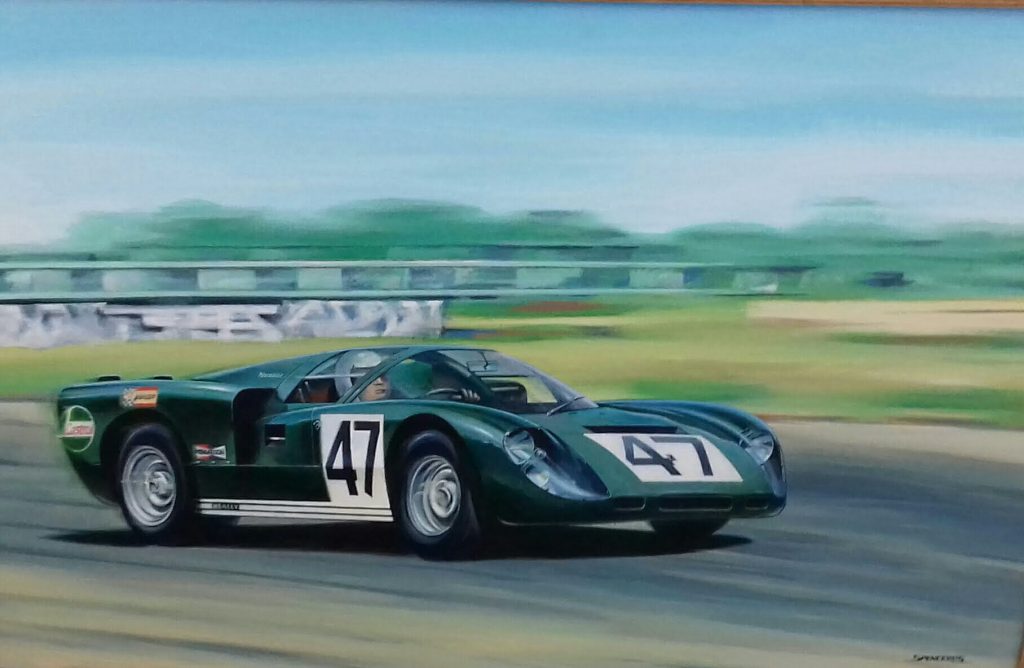
Interviewer: Now, you mentioned that you went to work for the family for a while. So, the last time we talked about work you were in the test area at Rootes. What happened? Take us through that a bit. **
JH: Well, when I left Dealer Customer Relations, at Rootes, I’d got fed up with the whole thing and, of course, part of my training was in the Experimental Department when I was a pupil and I really wanted something more interesting to do. I was talking to Daniel Richmond about it and he said, “Why don’t you go and have a word with Mr Peter Wilson, he’s Chief Experimental Engineer, I know him very, well”. So, I thought okay. I went up to the Experimental Department, the up and over doors, nobody is normally allowed in and I walked down the office and asked “Which is Mr Wilson’s office?” Someone pointed it out to me and I walked in. There was his secretary, in a separate office, and I said: “Can I have a word with him, Jean?”. Jean Harries was her name. She said, “I’ll ask”. I was invited in to speak to Mr. Wilson, I told him what I’d done, this, that and the other and he said: “Well, I think we can find you a job in about four months’ time, but you’re going to have to come and have a proper interview”. Which I did. Having failed everything (academically), Mr. Bill Broadbent wasn’t too pleased with having engineers with no ONCs or HNCs on the books. However, I wasn’t employed to be one of those, I was going to be employed as a test driver and a Development driver. I went up there and I didn’t think I’d ever hear another word. But I did. Bill Broadbent said to me “Well, you’ll have to go back to Tech one night a week”. I thought “Maybe”. I turned up there, this was around 1962, things went along fine at first but I didn’t appreciate the dictatorial management style and one day, in 1965, I “threw my dummy out of the pram” and found myself looking for another job. I ended up working for the family at Parkside Garage dealing with warranty claims etc. something that I had done during my pupilage at Rootes. I didn’t enjoy it much then and I wasn’t enjoying it in the family firm. Fate intervened again when in 1967 Quicks, the Manchester based Ford dealership made an offer to the Davies family which they could not refuse. One of the consequences of Quicks taking over Parkside was that family members and directors were made redundant. So, here I was looking for a job again.
Once again, good fortune was to befall me. The GT40 I was driving at Silverstone 1967 had broken down. There was Peter Wilson, standing as one of the RAC observers, he asked me what I was doing and I told him that I had just lost my job. He said, “Do you want your old job back, in road testing?” I said, “Oh, yes please”. But this time, there wasn’t any Mr Broadbent and my lack of ONCs was not of concern. There was a wonderful guy who had come from Rover called Ted Goronsky. He had been a Project Manager on the original Rover 2000. He was Chief Engineer of Vehicle Test and, of course, all the people that I had worked with were still there.
Interviewer: So they welcomed you?
JH: Yes. They were very kind. There were a lot more of them too because Chrysler had taken over Rootes and they thought you can’t run a Vehicle Test Department with only six engineers. So, I went back there and settled in, I would have stayed there for the rest of my life if the French hadn’t sacked me, and six hundred other engineers. I thought, ‘Well, my motor racing is over” but it wasn’t. I’d finished in 1970 really, my closest friend of ten years, Chris Summers, we were sharing a Formula 5000 Lola that year, 142, but Chris, up at Snetterton, he went off at the Norwich straight at about a hundred and seventy mph with a flat tyre, and that was the end of Chris. I thought, well I’ve done twelve years, I’ll stop. So I did. But then, in the early ‘70s, Des O’Dell, the Chrysler U.K. Competitions Department Manager, had started to do production saloon car racing under the Mopar (Chrysler’s “All Make” range of spare parts) brand name. (Chrysler employee Bernard Unett was the successful driver of a Chrysler Avenger ed.) Des said to me “Sometimes we’ve got to be sure that there’s three cars in the Class for Bernard to get the maximum points”. That resulted in me driving the odd race in somebody else’s Avenger. Then in ’74, Des said, “We’re going to run Hunter GLSs, I’d like you to come and be a proper member of the team”. So, out of retirement, I knew I was never going to catch Bernard because he was damn quick, he was one of the better drivers. So, at the end of ’74, that was the last race I ever did, and I’d done it sixteen years on and off.

Then along came the Subeam Lotus which was Des O’Dell’s bright idea. The last eighteen months of my working life at Chrysler, there was only my late boss, Peter Coleman and I, that were doing the vehicle testing on the Lotus Sunbeam. The then Director of Engineering said “Lotus are meant to be doing this, but we better make sure we know what they are up to, so look at the ‘Blue Book’, come up with the tests we think we need to do because of the changes”. So I wrote a whole rigmarole of tests to be done and we had six prototypes in Engineering down at Whitley, Coventry (Chrysler U.K.’s HQ and vehicle development centre, at the time, now JLR’s headquarters ed.) and ran through the test work for the production car, nothing to do with what Des was doing with the Rally cars.
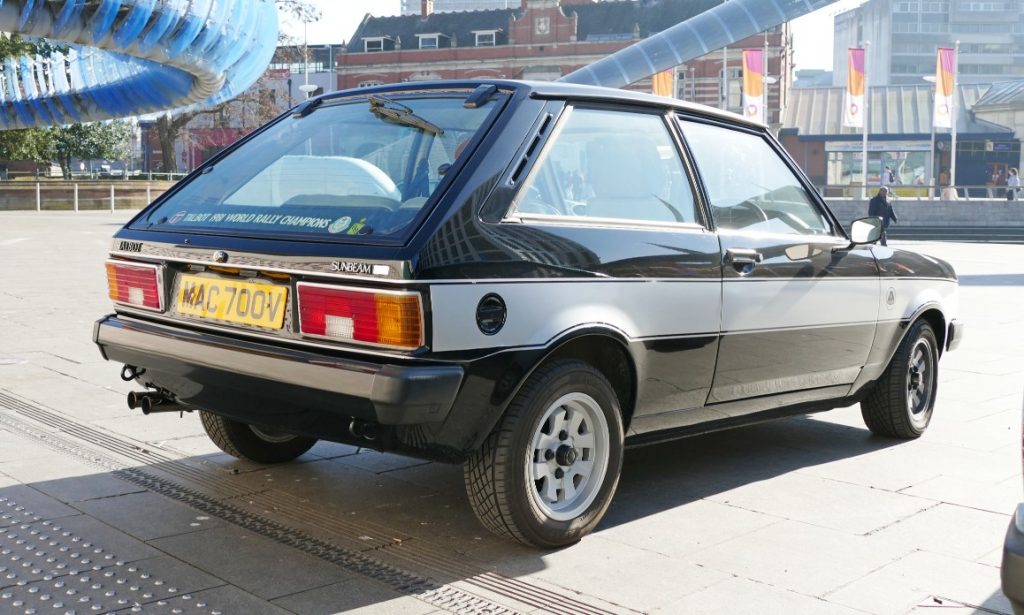
In 1978 Chrysler Europe had been bought by Peugeot S.A. (PSA). Once they had evaluated what they had taken over Peugeot decide to reduce the U.K. design and development department thereby making six hundred people redundant. I was one of them. So, once again I had to look for a job. I found one with Unipart, writing instructions on how to fit a wide range of accessories to Rover cars. In 1995 that section was absorbed into Rover at Canley, Coventry, fortunately not far from where I lived. I remained there until 1998 when I decided to retire aged 60.
Interviewer: Well, this has been an absolutely brilliant interview, we’ve covered many aspects of your life, particularly the racing with Healey and your personal career. So, John, thank you very much.
I would like to say than you to Kathryn Seren and Rosemary Whelan for all the hard work they did in transcribing the original recording.
Nick
© carsceneinternational.com
